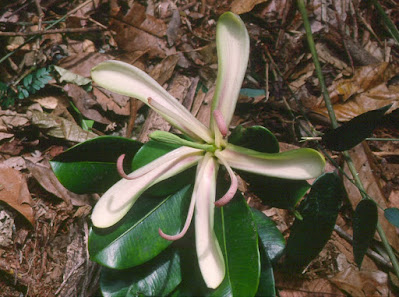Abstract
An integrative taxonomic study recognized a new species of the Cyrtodactylus pulchellus group from Kanchanadit District, Surat Thani Province, Southern Thailand. Phylogenetic analyses of the mitochondrial ND2 gene revealed a new species, Cyrtodactylus kanchanadit sp. nov., that is closely related to C. lekaguli. The new species differs from its sister lineage by bearing mean genetic divergence of 4.53% and significant differences in both mensural and morphometric characters (p < 0.05). Cyrtodactylus kanchanadit sp. nov. can be differentiated from the remaining members of the C. pulchellus species group because of its genetic divergence of ≥7.99% and a combination of differences in body size: 11–15 supralabial and 10–12 infralabial scales, 29–35 paravertebral tubercles, 18–23 longitudinal rows of dorsal tubercles, 32–37 rows of ventral scales, 20–23 subdigital lamellae on the fourth toe, 32–37 femoroprecloacal pores in adult males, and four or five dark body bands; weak tuberculation on body; absence of tubercles in the ventral body fold, absence of precloacal pores in females, and absence of scattered pattern of white tubercles on dorsum; presence of precloacal groove depression; and maculated white caudal bands. Cyrtodactylus kanchanadit sp. nov. is currently known from its type locality.
Keywords: bent-toed gecko; genetic; Southeast Asia; taxonomy
 |
| Live specimen of the adult male holotype of Cyrtodactylus kanchanadit sp. nov. (ZMKU R 01091) from the type locality in Pa Ron Subdistrict, Kanchanadit District, Surat Thani Province, Thailand. |
Cyrtodactylus kanchanadit sp. nov.
Diagnosis: Cyrtodactylus kanchanadit sp. nov. can be distinguished from all other species of the C. pulchellus group by a combination of the following characters: (1) SVL 92.5–101.1 mm in adult males (n = 4), 108.2–108.5 mm in adult females (n = 2); (2) 11–15 supralabial and 10–12 infralabial scales; (3) weak tuberculation on body; (4) no tubercles on ventral surfaces of forelimbs, gular region, or in ventrolateral body folds; (5) 29–35 paravertebral tubercles; (6) 18–23 longitudinal rows of dorsal tubercles; (7) 32–37 rows of ventral scales; (8) 20–23 subdigital lamellae on the fourth toe; (9) 32–37 femoroprecloacal pores in adult males; (10) absence of precloacal pores in adult females; (11) deep precloacal groove in males; (12) absence of scattered pattern of white tubercles on dorsum; (13) four or five dark dorsal body bands; (14) light caudal bands in adults infused with dark pigmentation; and (15) posterior portion of tail in hatchlings and juveniles white.
Etymology: The specific epithet kanchanadit refers to the type locality in Kanchanadit District, Surat Thani Province, Thailand.
Suggested common name: Kanchanadit Bent-toed Gecko ตุ๊กกายกาญจนดิษฐ์.
Korkhwan Termprayoon, Attapol Rujirawan, Larry Lee Grismer and Anchalee Aowphol. 2024. A New Species of the Cyrtodactylus pulchellus Group (Squamata: Gekkonidae) from Surat Thani Province, Thailand Underscores This Group’s Remarkable Diversity on the Thai-Malay Peninsula. Animals. 14(22), 3226. DOI: doi.org/10.3390/ani14223226
Simple Summary: This study discovered a new Cyrtodactylus population from Phet Phanomwat Waterfall in Southern Thailand. It has genetic divergences pertaining to mitochondrial NADH dehydrogenase subunit 2 (ND2) gene of ≥3.97% from its sister lineage, C. lekaguli, and bearing ≥ 7.99% genetic divergence from the congeners in the C. pulchellus group. This population can be separated from C. lekaguli by its morphologically significant differences. Based on the molecular and morphological evidence, this population is described as a new species, Cyrtodactylus kanchanadit sp. nov. The discovery of this new species increases the total number of Cyrtodactylus species to 377, of which 57 occur in Thailand.














--novataxa_2024-Bai_Wen.jpg)
--novataxa_2024-Bai_Wen.jpg)
--novataxa_2024-Bai_Wen.jpg)
























